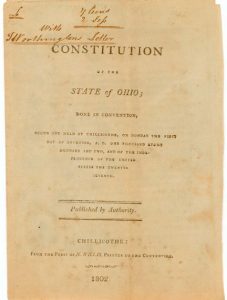
Editorial: Protect integrity of Ohio’s constitution
Columbus Dispatch 4/2/2017
The link is here
Ohio voters should be given the opportunity to ease the process of initiating state laws.
They also should be given the chance, in a separate ballot issue, to decide if initiating constitutional amendments should be more difficult.
Both would require amending the Ohio Constitution, which only voters can do.
For nearly three years, a committee of the Ohio Constitutional Modernization Commission has studied possible changes in initiated statutes and initiated amendments.
Only 15 state constitutions give voters the right to initiate both laws and amendments. The Ohio Constitution has provided those rights since 1912.
Since then, Ohioans using their constitutional rights to engage in direct democracy overwhelmingly have favored the amendment over the statutory route.
Of 80 attempts to initiate policy, petitioners have chosen to try to amend the constitution 68 times (85 percent). Initiated laws have been adopted only three times, most recently in 2006 to restrict smoking in public places.
Statehouse Democrats and Republicans agree that petitioners usually choose the amendment route for two reasons.
First, the requirements for getting on the ballot are nearly as difficult, and therefore nearly as costly, for a proposed law as for a proposed amendment.
Qualifying a proposed law for the ballot requires petitioners, as a first step, to collect signatures equal to 3 percent of the electorate. The proposal then goes to the General Assembly, which has four months to adopt, reject or modify it.
If the legislature rejects or modifies the proposal in a way unacceptable to petitioners, they must restart the petition drive and collect an additional 3 percent, totaling 6 percent of the electorate.
Second, even if Ohioans proposing an initiated law are successful in the election, nothing prevents the legislature from later repealing or amending the voter-approved statute.
Given these disincentives, petitioners rationally choose the amendment route. Voter-approved amendments, like the rest of the constitution, can only be changed by a public vote.
As a result, over time the Ohio Constitution becomes weighted with ornaments more suited to the Ohio Revised Code, such as livestock-care standards and casinos.
That’s why the modernization commission is considering how to ease the process of initiating state laws, and how to make the amendment process more difficult.
An idea gaining momentum is to create a 5 percent signature requirement for initiated laws, eliminate the supplementary petition requirement, and prohibit the General Assembly from changing any voter-enacted law for five years, except by a two-thirds vote.
Such a proposal has merit standing alone. However, majority Republicans appear intent on marrying it to a proposal requiring proposed amendments to receive 55 percent approval to win passage. Republicans also want to restrict initiated amendments to general elections in even-numbered years.
Some states have supermajority requirements for voter-initiated constitutional amendments. Florida, for example, requires 60 percent approval. Nevada requires a majority vote in two consecutive elections.
There is much to commend efforts to make initiated laws easier and initiated amendments harder.
However, the cleanest way to present these alternatives to voters is in two separate issues, not a combined one. When dealing with proposed changes to fundamental constitutional rights, voters should have an opportunity to judge each on its own merits.
Originally appeared in Columbus Dispatch. Reprinted with permission
